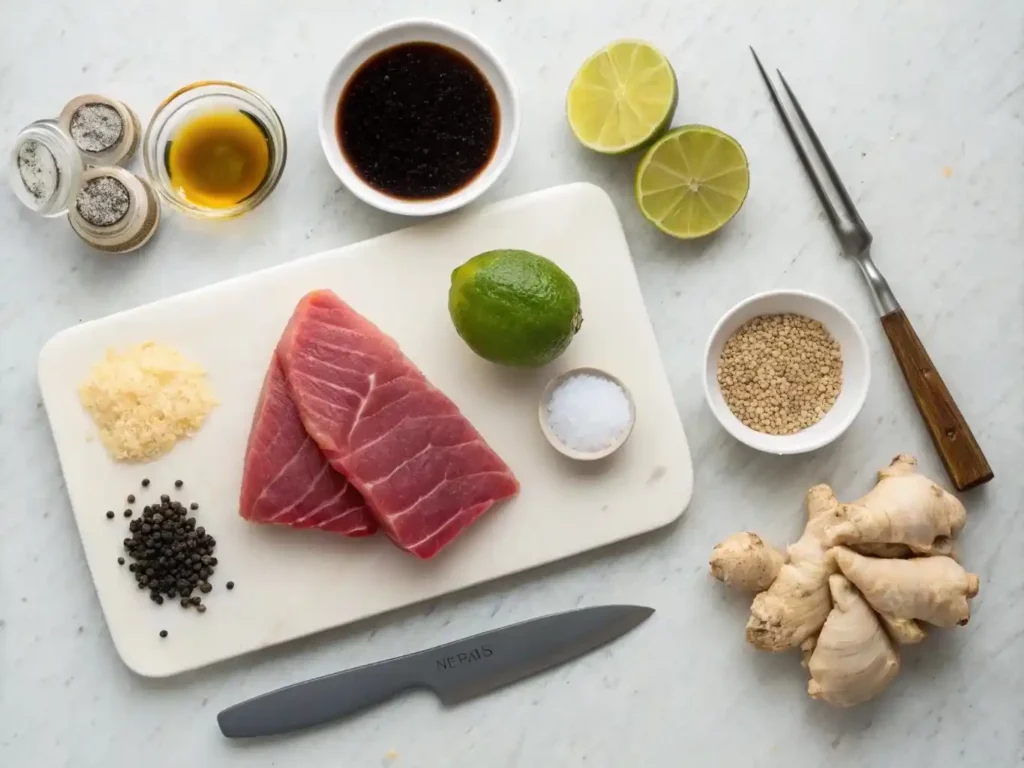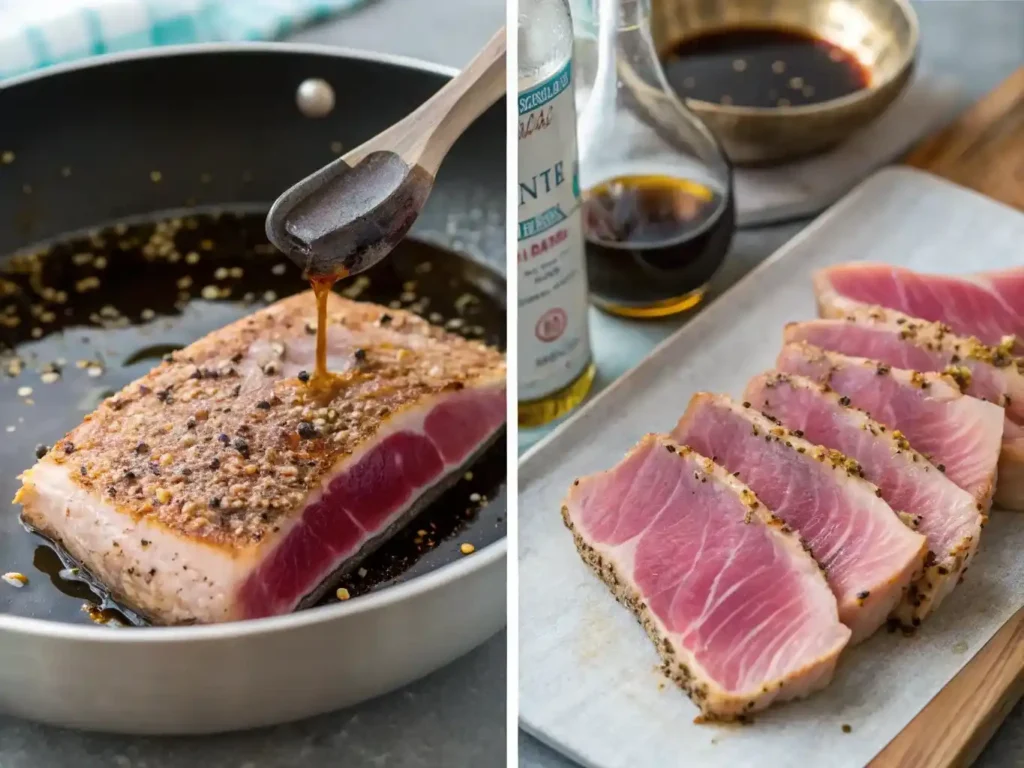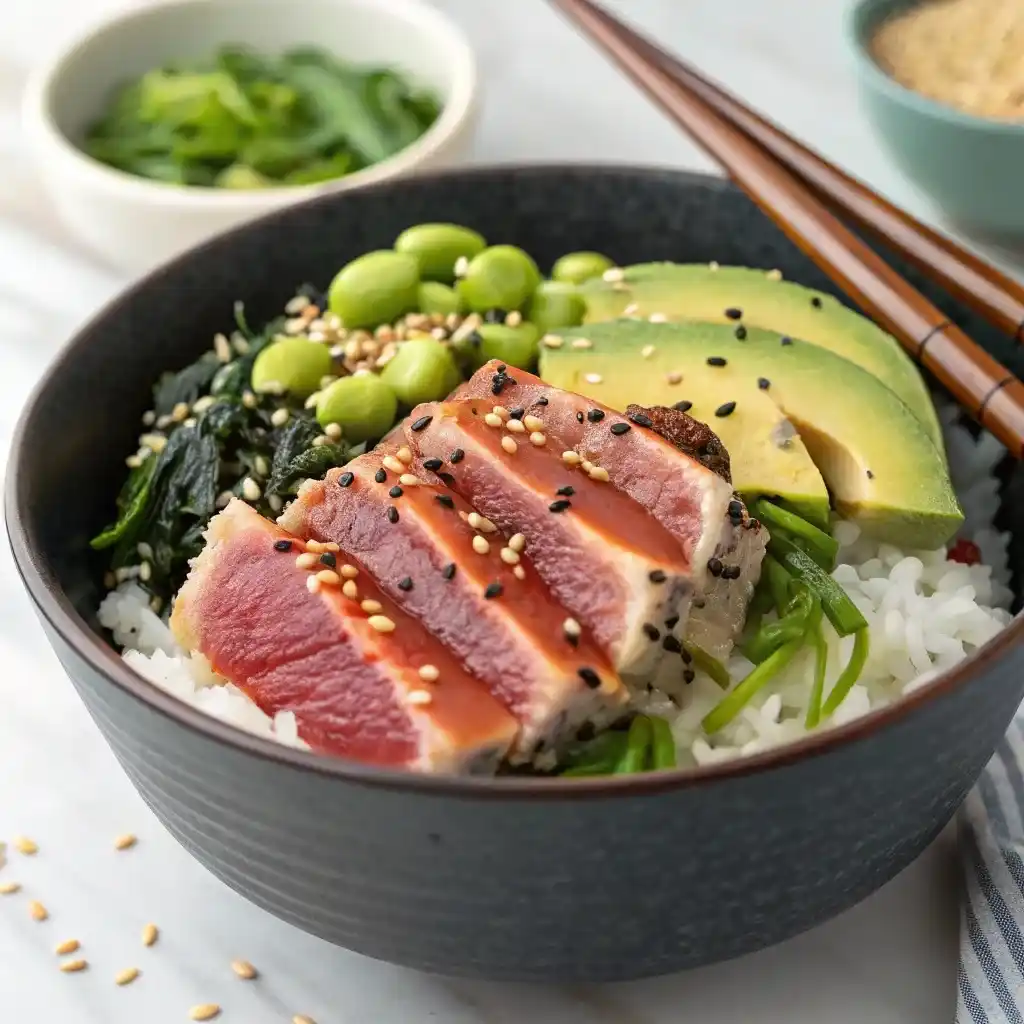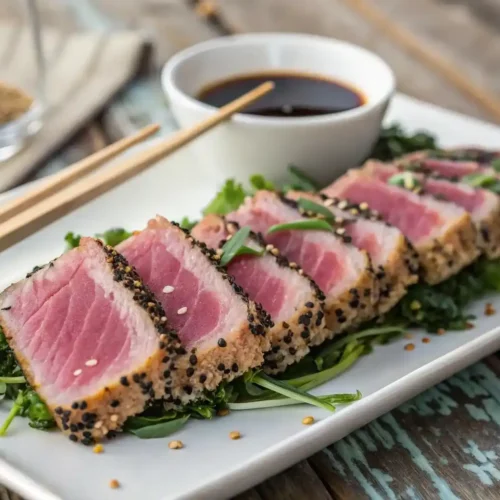Seared ahi tuna is a quick, flavorful dish that highlights the fresh quality of yellowfin or bigeye tuna, delivering a crispy seared exterior while keeping the center raw and tender. With minimal ingredients and a short cooking time—less than a minute per side—this method ensures a restaurant-quality meal in no time.
Choosing sushi-grade ahi tuna is key, as it is safe to eat raw and has a clean, meaty texture. Whether you prefer a simple seasoning of salt and pepper or a flavorful soy-sesame marinade, seared tuna is incredibly versatile. Enjoy it on its own, in a poke bowl, over rice, or with a crisp salad.
This high-protein, nutrient-rich recipe is easy to prepare and works for many diets. With the right technique, you’ll achieve perfectly seared ahi tuna that’s both delicious and visually stunning—ideal for quick meals or an elegant dinner.
Table of Contents
You’ll Absolutely Love Ahi Tuna Recipe

Preparing seared ahi tuna has many perks. Here are a few advantages people often note:
- Speedy Cooking
When you sear ahi, it takes just 1 minute per side or sometimes slightly more. Even a thick tuna steak will rarely require more than a couple of minutes per side. This keeps your total cooking time quick, so it’s perfect for busy evenings. - Perfectly Seared Exterior
The high-heat approach creates a firm outer crust. Some cooks aim for a sesame crust by coating the fish in sesame seeds before the sear. The result is perfectly seared edges around that tender interior. - Retained Freshness
With a fast sear, the inside stays moist. The short cooking period preserves the original flavor and texture that make fresh tuna special. If your tuna steaks are sushi grade, this center is safe to eat even when leaving the inside raw. - Nutrient-Rich
A tuna steak is high in protein, low in fat, and features beneficial omega-3 fatty acids. It supports a health-conscious lifestyle, and you can pair it with colorful vegetables or whole grains for a balanced meal. - Versatile Serving Options
You can serve seared ahi tuna in many ways. Enjoy it in a poke style, slice it for salads, or create a complete tuna with rice bowl. Whether you want a spicy flair or a citrus-infused marinade, you have plenty of room to experiment. - Great Recipe for Guests
The final plate looks elegant, and the pink interior stands out visually. This is a great recipe to impress friends at dinner parties. Most guests appreciate seeing gorgeous ahi tuna steaks lightly seared and cut into neat slices.
Ingredients to make Ahi Tuna Recipe

Every cook has a personal preference for seasonings, but a classic approach includes:
- Ahi Tuna Steak (also known as yellowfin, which is also known as yellowfin if you see it labeled that way)
- Each piece should be around 1-inch thick. Steaks that are at least 1 inch thick are easier to handle and sear well.
- You can use fresh ahi or frozen tuna (thawed correctly). Some might consider canned tuna, but that doesn’t work well for searing.
- Soy Sauce
- Adds savory depth.
- If you are sensitive to gluten, gluten-free soy sauce works.
- Sesame Seeds
- You may opt for toasted sesame seeds or plain.
- They create a crunchy sesame crust when combined with sesame oil.
- Sesame Oil or Toasted Sesame Oil
- Provides a nutty aroma.
- A small amount blends into your marinade or can be brushed on the fish before the sear.
- Avocado Oil
- Good for cooking over high heat.
- Choose this or another neutral oil so you can focus on the taste of the fish.
- Marinade Ingredients (Optional but Recommended)
- Garlic, grated ginger, citrus juice, a dash of chili sauce.
- Combine them in a bowl for a flavor boost before you sear.
- Salt and Pepper
- Basic but vital.
- Season to taste right before you sear ahi.
- Additional Choices
- Poke style garnishes (scallions, seaweed, sesame seeds).
- Dipping sauce made from soy sauce, wasabi, or a quick aioli.
Gather everything before you start. Having a complete overview of your recipe ingredients makes cooking smoother.
Step-by-Step Guide: Preparing a Delicious Ahi Tuna

These steps will help you achieve a balanced sear while leaving the inside raw if you choose:
- Prepare the Marinade
- In a bowl, combine your marinade ingredients: soy sauce, a bit of sesame oil, maybe some grated ginger, garlic, and a splash of lemon or lime juice. You can adjust these based on preference.
- Stir to blend. This forms the core flavor.
- Marinate the Tuna
- Place in a glass or glass or ceramic dish that can hold your tuna pieces flat.
- Put the ahi tuna steak into the dish, then pour marinade on top.
- Turn fish over at least once to make sure all surfaces get coated.
- If you have time, you can cover tightly and leave it in the fridge overnight for deeper flavor. Even a quick 15-30 minutes of marinade time will do if you are in a hurry.
- Heat the Skillet
- Add oil in a large heavy skillet. Set the burner to medium-high or high.
- Wait until the pan is hot. This is vital for a proper sear. If your skillet is not fully heated, the fish might cook too slowly and won’t develop that firm crust.
- Pat the Tuna Dry
- Take the tuna out of the marinade.
- Gently pat the ahi tuna steaks with paper (towels) to remove excess moisture. This step helps the exterior crisp up when it meets the heat.
- Season and Sear
- Lightly sprinkle salt and pepper on both sides.
- You can press sesame seeds onto each side if you want a sesame crust.
- Carefully with a flat spatula, lower the tuna into your hot pan.
- Sear for about 1 minute per side, especially if you like it very pink in the middle. Thicker pieces might take closer to two minutes per side. This range helps you keep it raw on the inside.
- Flip and Continue
- Use tongs or a spatula to flip the steak gently.
- Sear the second side for another minute on each side if you prefer a consistent pink center. If you want a more well-done interior, extend each side by an additional minute or so.
- Remove and Rest
- Once done, transfer seared tuna to a cutting board. Let it rest for a minute to lock in the juices.
- Use a very sharp knife to slice thinly. Thin slices highlight the beautiful color contrast and keep the fish tender.
- Serve Immediately
- Arrange the slices on a platter or over a bed of rice.
- Drizzle with extra marinade (if you reserved some before placing the raw fish in it) or serve a simple dipping sauce on the side.
Following these steps will help you sear the tuna steaks without overcooking. The entire process is quick, making it an easy recipe once you have everything on hand.
A New Way to Start Your Day with Ahi Tuna

Below are ideas to enhance your seared ahi experience or make tweaks:
- Skillet Choice
- A cast iron skillet retains heat well, ensuring a solid sear. If cast iron is unavailable, use a sturdy stainless-steel pan.
- Marinate Strategically
- Marinate (the fish) for at least 15 minutes if time is short. Overnight in the fridge increases flavor. If you leave it too long, the fish can lose its firmness, so balance your marinade time.
- Sesame Crust Variation
- Before you sear ahi, press a mix of white and black sesame seeds all over the steak. This forms a crisp sesame crust and adds visual appeal.
- Tuna Poke Twist
- If you love Hawaiian flavors, cut the fresh ahi into cubes, toss it with soy sauce, onions, and sesame oil for a tuna poke dish. You could still do a brief sear on some cubes if you want a different spin.
- Ahi Tuna Poke Bowl Option
- For a complete meal, place your seared slices on top of steamed rice along with avocado, pickled ginger, and a drizzle of spicy mayo. This creates a satisfying poke bowl or tuna poke bowl with fresh vegetables.
- Also Known as Yellowfin
- Many stores label yellowfin as “ahi.” Double-check what species you are buying if that matters to you. Tuna varieties can have slight differences in taste and color.
- Handling Frozen Ahi Tuna
- You can use frozen ahi tuna if fresh tuna is unavailable. Thaw it properly in the fridge before cooking. This helps maintain safety and flavor.
- Use a Very Sharp Knife for Slicing
- A dull blade can tear the tuna, preventing clean edges. If you keep your cut neat, the center of the steak remains appealing.
- Cook Times
- Many cooks love sear ahi for about 1 minute per side. But if your pieces are thicker, you might need two or three minutes per side to get the right exterior. Adjust based on your preference.
- Albacore Tuna Variation
- While this recipe focuses on ahi, you can adapt similar steps for other types like albacore tuna. The main difference is the color and taste, but the sear process remains the same.
Serving Suggestions

Seared ahi can be served in countless ways. Here are some options to get you started:
- Tuna with Rice
- Layer the sliced tuna over white or brown rice. Add steamed vegetables or a side salad. This approach highlights the fish as the main star of the plate.
- Poke Bowl
- Combine your sliced or cubed seared tuna with avocado, cucumber, pickled carrots, edamame, and a zesty sauce. The concept of a poke bowl is popular because it mixes fresh ingredients in a single dish.
- Dipping Sauce
- A side of soy sauce, wasabi, or even spicy mayo works well. You can also stir up a quick dipping sauce from soy sauce, lime juice, and sesame oil.
- Sesame Crust Flair
- If you made a sesame crust, keep extra toasted sesame seeds on the side for sprinkling. Serve with a wedge of lime or lemon for brightness.
- Seafood Recipes Pairing
- If you like variety, serve seared tuna alongside grilled shrimp or seared scallops. It’s a fun way to make a buffet of different seafood recipes for a gathering.
- Salad Topping
- Slice the tuna and lay it over a bed of mixed greens. Add cherry tomatoes, cucumber, and a tangy dressing. The fish adds protein and color.
- Noodle Bowl
- Cook soba or ramen noodles, toss them in a light sauce, and place the seared tuna on top. Garnish with scallions and seaweed for a Japanese-inspired meal.
Conclusion
Learning how to sear ahi is a gateway to many creative meals. When you invest in sushi grade fish, you can confidently enjoy the benefits of a slightly raw on the inside center. If you followed the recipe step by step, you should have a tasty dish that showcases fresh ocean flavor. You can even alter the recipe next time by adding extra spices or changing the marinade profile.
Remember that seared ahi is best eaten as soon as it’s cooked. If you do have leftovers, store them in an airtight container in the fridge and use them the next day in a salad or wrap. Try not to reheat them too much, since that might dry out the fish. Once you feel comfortable with this preparation, you can add it to your rotation of fish recipes, especially on busy weeknights.
If you enjoy variety, you can switch between yellowfin and bigeye tuna, or even explore albacore tuna. The same fundamental technique holds: sear over high heat for a short time, keep an eye on the color, and slice it neatly before serving. Feel free to share your searing success with friends at dinner gatherings or celebrations. It is a great recipe to impress anyone who enjoys a light yet satisfying seafood entree.
FAQs
1.What is seared ahi tuna?
Seared ahi tuna is a lightly cooked yellowfin or bigeye tuna steak that is quickly seared over high heat, leaving the inside raw while creating a flavorful, crispy outer crust. This method preserves the tender texture and natural richness of the fish.
2. Is ahi tuna good cooked?
Yes, but it’s best when lightly seared rather than fully cooked. Overcooking can make ahi tuna dry and tough. If you prefer a cooked version, aim for a light pink center to retain its moisture and flavor.
3. What kind of tuna is ahi?
Ahi tuna refers to two species: yellowfin tuna (Thunnus albacares) and bigeye tuna (Thunnus obesus). Both are commonly used for sashimi, sushi, and seared tuna dishes due to their mild flavor and firm texture.
4. Is ahi tuna safe to eat rare?
Yes, if it is sushi-grade and properly handled. Sushi-grade ahi tuna is processed and frozen according to food safety standards to eliminate parasites, making it safe to eat rare or raw. Always buy from a trusted source.
5. What is the difference between ahi tuna and regular tuna?
Ahi tuna” specifically refers to yellowfin or bigeye tuna, which have a firmer texture and mild flavor. “Regular tuna” is a broad term that includes albacore (lighter, milder taste) and bluefin (rich, fatty texture), which differ in flavor, fat content, and use in cooking.
6. What seasoning is good for tuna?
Ahi tuna pairs well with simple seasonings like salt, pepper, garlic powder, and sesame seeds. For more flavor, use a marinade with soy sauce, toasted sesame oil, ginger, citrus juice, or chili flakes before searing.

Seared Ahi Tuna Recipe You’ll Absolutely Love
Ingredients
Ahi Tuna Steak (also known as yellowfin, which is also known as yellowfin if you see it labeled that way)
- Each piece should be around 1-inch thick. Steaks that are at least 1 inch thick are easier to handle and sear well.
- You can use fresh ahi or frozen tuna thawed correctly. Some might consider canned tuna, but that doesn’t work well for searing.
Soy Sauce
- Adds savory depth.
- If you are sensitive to gluten gluten-free soy sauce works.
Sesame Seeds
- You may opt for toasted sesame seeds or plain.
- They create a crunchy sesame crust when combined with sesame oil.
Sesame Oil or Toasted Sesame Oil
- Provides a nutty aroma.
- A small amount blends into your marinade or can be brushed on the fish before the sear.
Avocado Oil
- Good for cooking over high heat.
- Choose this or another neutral oil so you can focus on the taste of the fish.
Marinade Ingredients (Optional but Recommended)
- Garlic grated ginger, citrus juice, a dash of chili sauce.
- Combine them in a bowl for a flavor boost before you sear.
Salt and Pepper
- Basic but vital.
- Season to taste right before you sear ahi.
Additional Choices
- Poke style garnishes scallions, seaweed, sesame seeds.
- Dipping sauce made from soy sauce wasabi, or a quick aioli.
Instructions
Prepare the Marinade
- In a bowl, combine your marinade ingredients: soy sauce, a bit of sesame oil, maybe some grated ginger, garlic, and a splash of lemon or lime juice. You can adjust these based on preference.
- Stir to blend. This forms the core flavor.
Marinate the Tuna
- Place in a glass or glass or ceramic dish that can hold your tuna pieces flat.
- Put the ahi tuna steak into the dish, then pour marinade on top.
- Turn fish over at least once to make sure all surfaces get coated.
- If you have time, you can cover tightly and leave it in the fridge overnight for deeper flavor. Even a quick 15-30 minutes of marinade time will do if you are in a hurry.
Heat the Skillet
- Add oil in a large heavy skillet. Set the burner to medium-high or high.
- Wait until the pan is hot. This is vital for a proper sear. If your skillet is not fully heated, the fish might cook too slowly and won’t develop that firm crust.
Pat the Tuna Dry
- Take the tuna out of the marinade.
- Gently pat the ahi tuna steaks with paper (towels) to remove excess moisture. This step helps the exterior crisp up when it meets the heat.
Season and Sear
- Lightly sprinkle salt and pepper on both sides.
- You can press sesame seeds onto each side if you want a sesame crust.
- Carefully with a flat spatula, lower the tuna into your hot pan.
- Sear for about 1 minute per side, especially if you like it very pink in the middle. Thicker pieces might take closer to two minutes per side. This range helps you keep it raw on the inside.
Flip and Continue
- Use tongs or a spatula to flip the steak gently.
- Sear the second side for another minute on each side if you prefer a consistent pink center. If you want a more well-done interior, extend each side by an additional minute or so.
Remove and Rest
- Once done, transfer seared tuna to a cutting board. Let it rest for a minute to lock in the juices.
- Use a very sharp knife to slice thinly. Thin slices highlight the beautiful color contrast and keep the fish tender.
Serve Immediately
- Arrange the slices on a platter or over a bed of rice.
- Drizzle with extra marinade (if you reserved some before placing the raw fish in it) or serve a simple dipping sauce on the side.
Notes
Nutrition Information (Per Serving)
- Calories: 250
- Protein: 40g
- Total Fat: 10g
- Saturated Fat: 2g
- Carbohydrates: 2g
- Fiber: 1g
- Sugar: 0g
- Cholesterol: 50mg
- Sodium: 300mg
Recipe Categories
- Course: Main Course, Appetizer
- Cuisine: Asian, Japanese, Hawaiian
- Diet: High-Protein, Low-Carb, Keto, Paleo, Gluten-Free
- Method: Pan-Searing, Quick-Cooking
- Keyword: Seared Ahi Tuna, Tuna Steak, Healthy Seafood, Quick Dinner
- Skill Level: Easy











